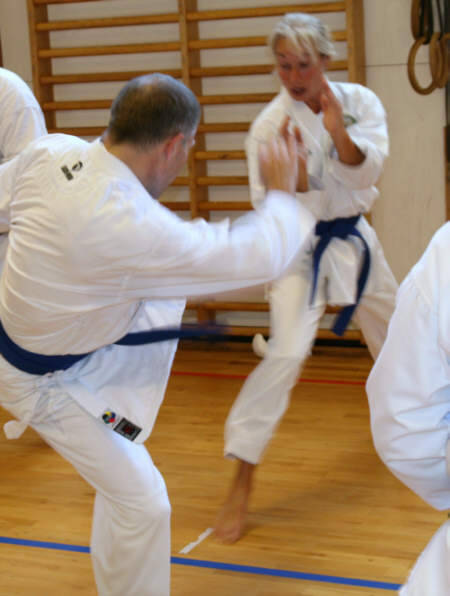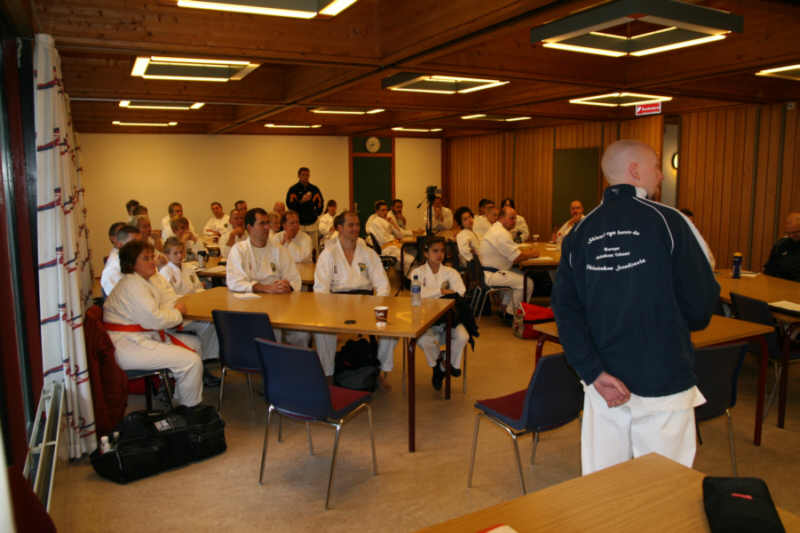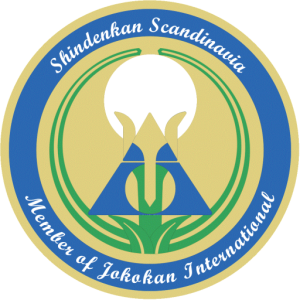
By Jokokan Honbu
On Saturday, October 4 and November 15, 2008, the first Task fighting courses (TF-K1 and TF-K2) were held with respectively Half day and full day course.
Yakami Shinsei-ryu Karate-do is traditional Karate-do with a traditional mindset behind it, and with room for everyone. We have experience so that everyone can learn to defend themselves in a trained, adjusted and controlled way if they are exposed to a threat. Just like with the school system, all practitioners must first be thoroughly trained and prepared in the possibilities of the various techniques, and the psyche is prepared and built up to want to test these during a sports match, where the speed of attack and defense is free, and contact can and will occur. This will still be under safe and secure conditions.
But at the same time, it is also important that a realistic test takes place, so that no unintentional illusions about one's own ability are built up. At the same time, it is also better to try out unfortunate situations in the gym than out on the street for the first time. The statistics also support this preparation with timely care, as the violence has become more serious and it no longer distinguishes between boy or girl, man or woman. A fight is also by its nature wild and unrestricted, and can consist of punches, kicks, "wrestling" and floor fighting etc. Learned techniques for and against this are contained in Yakami Shinsei-ryu Karate-do's curriculum, and therefore also contained in Shindenkan sports freestyle - step by step.
The purpose of Shindenkan's freestyle concept is to test one's own techniques and psychological reactions, so that realism and learning can take place on a good, but still safe and secure level. This means that everyone can complete Shindenkan sports freestyle under safe and secure conditions, but still with a certain realism, and a greater understanding of the advantages and disadvantages of the various techniques trained.
Task fighting course 1 was well attended with 40 participants and with 29 participants for the continuation on Task fighting course 2, which was five weeks after the basic course, so that what was learned could be practiced in the intervening time. The pass percentages were respectively 100 % and 85 %, which is very satisfactory.
Task fighting course 1 is targeted at the student group of 7-5.kyu and at the same time acts as a clarification course, which gives the participants a practical experience, familiarization and introduction to what free fighting can be.
Task fighting course 2 is targeted at the group of 4-2.kyu students, and functions as an extended course both on the practical part, but also on the communicative part, so that local assistant instructors can answer typical questions from students through an increased understanding of functions and system-wise connections in the entire Shindenkan free-kamp concept.
Together, the two new Honbu assistant instructors have fought over 750 matches in 10 different countries, won over 50 medals with four WC medals in Japan on top. Both have trained karate for over 25 years, one of which totaled 2½ years in Japan. For respectively 10 and 11 years ago they both switched to Shindenkan (Jokokan) when they experienced being outclassed by Shindenkan brown belts in combat despite their very fine martial arts CV, and are now both chief instructors for local schools in Shindenkan Denmark.
During the summer vacation, Kimu Sensei had designed the concept and "drawn the lines in the paintings", so that the two Honbu instructors for TF-K1 and TF-K2 could "paint the painting in the right colors", at the same time that Kimu Sensei through the month-long preparation process able to coordinate and ensure the common thread through both courses. The collaboration between TF-K1 and TF-K2 Honbu instructors, Kjeld Nyrup Renshi-dai, 4th dan and Brian Jessen Renshi-dai, 3rd dan, worked flawlessly and was further secured through the fact that Kimu Sensei was constantly on the sidelines and with regular work meetings of 3-6 hours duration.
This therefore also meant that the new Honbu assistant instructors went through an intensive instructor training course with Kimu Sensei based on specific Honbu curriculum courses, which meant that Kimu Sensei has continuously trained the four new Honbu assistant instructors over two teams over the last five months, so that the continuity , knowledge sharing, quality, curriculum level, advice thread and instructor development can be continued for Shindenkan's future and development. To give an idea of the intensity, it took approx. 75 working hours for each of the instructor courses (I-K1 & I-K2), a total of approx. 150 working hours for a total of 6 hours of teaching. That is 25 working hours per Honbu course teaching hour. It took respectively 125 and 250 working hours for each of the Task Fighting curriculum courses (TF-K1 & TF-K2), together approx. 400 working hours for a total of 10 hours of teaching. That is 40 working hours per Honbu course teaching hour. So in total there are approx. 550 voluntary and unpaid working hours behind the two curriculum course packages, which corresponds to approx. four months of full-time work with a 37-hour professional working week.
All the new Honbu assistant instructors are members of the Kaidenkan. This also means higher demands and responsibilities for them, but also that they are taught the curriculum course prepared by Kimu Sensei over months in such a way that they are given a relatively complicated assembly kit, instruction manual and the finished image of the target, after which the instructor the team is required to assemble the finished image of the target. The instructor team is continuously supported by Kimu Sensei, so that the image of the goal is secured, but also that the development and training process is secured.
Task fighting course 1 has a weighting of 15 % in the classroom and 85 % practice in the dojo. The theory briefly covered information and an overview of the entire Shindenkan freestyle concept, the connection to the curriculum and what it can be used for. After the short theory, the trip went down to the dojo, where "Ippon kumite" was trained with a special purpose. In its simplicity, there is a very big difference between whether you constantly train with an optimal attitude or "let your mind wander". The black belt group from 2-6.dan could also feel and recognize this at the subsequent course for dan degrees, where Kimu Sensei taught as usual. The course was also a foretaste. What kumite traditionally could be, so that all participants of all ages could get used to and learn practically from this form of kumite. But throughout the course there was laughter and thoughtfulness to be felt and heard. Laughter is the liberating part and thoughtfulness the learning part - we think that at Shindenkan is a really good combination for the purpose.
There were 40 participants registered and all passed.
Instructor course 2 has a weighting of 35 % in the classroom and 65 % practice in the dojo, and concluding with a written test where each student had to obtain at least 65 % correct answers to pass.
In Shindenkan, anyone who wants to is taken through all the different known forms of kumite martial arts. We build up all students and train them in battle, so that they "don't have to invent the wheel and the deep plate", which has been invented. We believe that knowledge sharing and good preparation are 80 % of success, and we must build on this. This ranges from traditional over the martial arts skin-touch to semi-contact to full contact and MMA to finally end with traditional Bujutsu without rules. The theoretical part was supported by various videos, so that all the participants could get a good sense of what the differences consisted of. Next, the trip went down to the dojo, where they trained according to the martial arts rules in skin-touch through various combinations. I-K2 was then completed with a written test of approx. 30 minutes duration. Of the 29 students registered, 26 passed.
The feedback from the courses was divided over two rounds. The first course was over 85 % very satisfied. The last 15 % would have had much more competition, closer contact and were in doubt as to what they could use the course for. But this was changed during the second course, when the common thread dawned on everyone, resulting in 100 % satisfaction.
Postscript:
In Shindenkan, you get what you are good at, which requires constant effort and focus, which increases the further you progress through the grades.
This year there are 51 students who have passed instructor course 1 and 21 students who have passed instructor course 2.
As can be seen from our website, there are ten scheduled instructor courses. Numbers 5 and 6 are for school heads and are called “Shishu”, with a direct connection to the densho degrees SHODEN and CHUDEN. Instructor course 7 is for new Honbu 1 assistant instructors with a direct connection to the densho degree JODEN, and instructor course 8 is for Honbu 1 instructors, with a direct connection to the densho degree OKUDEN. This means that these instructor courses have a practical and a personal part.
In Shindenkan, degrees and titles are not just given away. This requires a large and continuous development effort. The four new Honbu assistant instructors went through an intense Kaidenkan instructor training course with Kimu Sensei. In total, more than 550 working hours were used to pass instructor courses 5, 6 and 7.1 over several months. Instructor course 8 takes 9-18 months, approx. 300-500 teaching hours by Kimu Sensei and a gigantic effort by the student himself.
Kimu Sensei has developed all training courses in Shindenkan and Kaidenkan Honbu Dojo's according to Jokokan International standard and graduation proxy.
The following passed during the Shindenkan X-mas convention, May 13, 2008:
Instructor course 5, 6 and 7.1: The Renshi Dais: Søren Nielsen, Martin Hansen, Kjeld Nyrup and Brian Jessen.
Instructor course 5, 6, 7 and 8: Kyoshi: Jens Iversen





